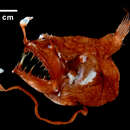en
names in breadcrumbs


View data on Catalog of Fishes here.
Frontal spines absent; angular spine and that at symphysis of lower jaw relatively short; sphenotic and preopercular spines shortest in largest specimens (as in other species of the genus); two to three pairs of vomerine teeth in specimens greater than 35 mm; number of jaw teeth increasing with standard length from 11–14 to 17–21 on each side of upper jaw, from 5–10 to 10–15 in lower jaw; longest tooth (posteriormost in anteriormost series of dentary) 12–21% SL; dorsal-fin rays 3; anal-fin rays 2 or 3; pectoral-fin rays 13 or 14.
A concentration of subdermal pigmentation on caudal peduncle discernible in smallest specimens. Length of illicium 19–35% SL, shortest in juvenile holotype (19%) and in largest known specimen (24%); external pigmentation of esca increasing with age, completely covering escal bulb and appendages in largest known specimen (except for a narrow field behind the distal escal appendages); morphology of escal and barbel appendages varying without distinct relation to size of specimens; length of distal prolongation of escal bulb varying from about 0.5–1.5 times diameter of escal bulb, its distal bifurcation ranging from an indistinct low cleft to separation into a pair of short conical branches; position of smaller pair of appendages (in relation to base of escal prolongation) varying between lateral and posterior; some specimens with both pairs of distal appendages have nipple-like tips; posterior appendage varying from a small, blunt or pointed papilla to a compressed, somewhat larger flap. Branching of distal tassel of barbel ranging from blade-shaped with a single series of more or less sessile photophores along compressed edge, to truncated, with a distal concentration of photophores, and to brush-shaped, consisting of a cluster of stalked photophores.
Barbels of two specimens differing to such a degree from those of other specimens as well as from each other that they may represent separate species (for which reason they have been referred to as L. aff. coronata A and B (see Bertelsen, 1982:2, fig. 5); both differ from other specimens in having a longer barbel (321 and 358% SL versus 90–276%), in having a number of lateral branches on stem of barbel (versus none), and some branches of terminal tassel prolonged and branched (versus shorter and unbranched); L. aff. coronata A from Eastern Tropical Atlantic with lateral branches branched and restricted to distal half of stem; L. aff. coronata B from Eastern North Pacific with lateral branches of barbel simple and distributed throughout length of stem of barbel.
Two largest females (219–225 mm) with parasitic males, one represented by only a small remnant; the other well preserved, 26 mm, with pointed sphenotic spine, pattern of larval subdermal melanophores obliterated by secondary pigmentation.
Metamorphosed females of Linophryne coronata differ from those of other species of the genus in details of escal and barbel morphology: escal bulb with a distal prolongation, conical at base and distally more or less deeply bifurcated; a second, shorter pair of blunt, conical posterolateral appendages; posterior appendage short, conical or compressed; additional escal appendages absent. Barbel with long undivided stem and a distal tassel of branches; total length 90–276% SL (321–358% in tentatively referred specimens); stem of barbel without filaments or lateral branches (except in tentatively referred specimens); distal tassel more or less distinctly divided into 3 or 4 basal and 3 terminal branches; most branches compressed and pointed, tapering into a filament with a photophore on tip and with a single series of sessile or stalked photophores along one edge; length of tassel 8.5–28% SL (35–61% in tentatively referred specimens). Juvenile females with some concentration of subdermal pigment on caudal peduncle. Parasitic males with pointed sphenotic spines.
Most of the known material of L. coronata was collected from the Western North Atlantic between 20 and 50°N, but one (219 mm) is from Iceland, one (L. aff coronata A) from off West Africa at about 10°N, and another two (including L. aff. coronata B) from the Eastern North Pacific.
Meso- to bathypelagic. The two largest females (219–225 mm) were caught in a commercial bottom trawl at 90 and 370–480 m, respectively, another was taken in a pelagic closing net between 1000–1250 m, and the remaining specimens in open pelagic nets with maximum fishing depths of 1000–3000 m.
Pietsch TW. 2009. Oceanic Anglerfishes: Extraordinary Diversity in the Deep Sea. Berkley: University of California Press. 638 p.
Bertelsen E. 1982. Notes on Linophrynidae VIII: A review of the genus Linophryne, with new records and descriptions of two new species. Steenstrupia 8(3):49–104.
Parasitized females have a single attached male, in contrast to the linophrynid genera Haplophryne and Borophryne (and the ceratiid genera Ceratias and Cryptopsaras) in which females with two or more males are known. In all known cases parasitized females of the family, the male is directed forward with respect to the female and attached in nearly the same position on the ventral midline of the female, somewhat in front of and below the sinistral anus; with only one or two exceptions, all are attached upside down with respect to the female. This is again in contrast to the linophrynid genera Haplophryne and Photocorynus (and the ceratiid genus Cryptopsaras) in which males may attach in any direction and almost anywhere on the head and body of the female. In all known examples, the males are attached by both upper and lower jaws, leaving prominent openings on each side that lead into their mouths and opercular cavities; there is no papilla of tissue projecting from the female into the mouth of the male.
Known from twenty-two metamorphosed females (29.5–225 mm), including three specimens (29.5–51.5 mm) tentatively referred to this species; and four parasitic males (18–26 mm, one represented only by partial remains).
PAWNEE station 39, Bahamas, 22°43'N, 74°23'W, open pelagic net, 8000 ft of wire, 29 March 1927.
Holotype of Linophryne coronata: BOC 2005, 33 mm.